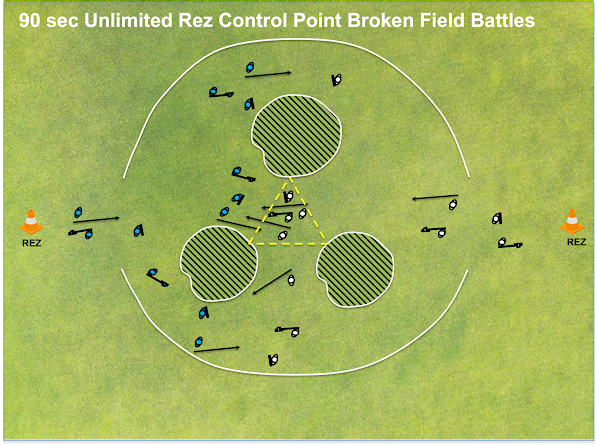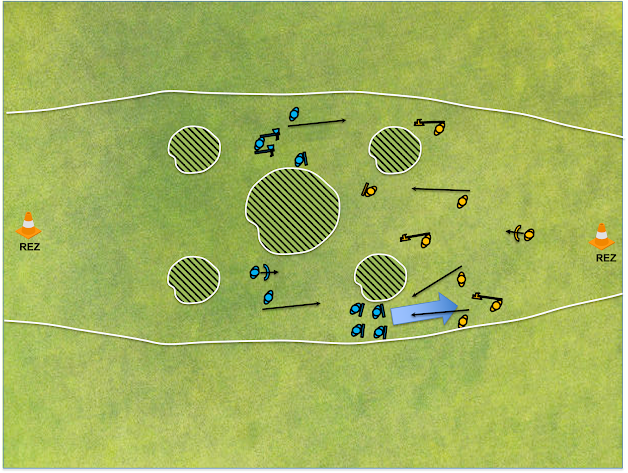We had a fantastic practice this weekend! I fought until I could no longer hold up my spear. I had to repeatedly stand up at dinner because my body kept cramping up. Lots of positive feedback. We're hoping to do this again in the spring.
What was this?
Lady Teagan of Anglesey and Master Alric the Mad had been working on a plan for quite some time to put together a cross kingdom practice in the Baltimore, MD area in order to bring together different groups of people to test each other's mettle against. They let me and Sir Arundoor of Anglesey run the scenarios and lead the feedback sessions, with THL Ozwin (sp?) stepping on to marshal the last scenarios.
The Format
1) Bring everyone together for a SHORT discussion about the format for the day.
2) Run a short scenario. Give both sides a chance to work out among themselves what did and didn't work, make changes, and then run the scenario again. Offer short, simple observations but don't stop and lecture. Give them a chance to figure it out on their own.
3) Once everyone is tired, give them a break. Bring everyone together to talk about big ideas, lessons learned, etc. Let the fighters give feedback, but keep it short.
4) Repeat steps 2 & 3 until the fighters are out of gas for the day.
5) Give people a chance to do some singles fighting, or work on some specific skills.
6) Bring everyone in for one last talk where each person gets their chance to say what they liked about the day, and what they thought could be improved. This really makes everyone feel a sense of ownership of the practice, while giving the people who run the practices some good feedback.
The Scenarios
1)
Before I get into the details, I want to talk about how different each of these scenarios were despite looking very similar on the surface.
1) Need for an immediate plan. Quick execution. Even quicker reform and reengagement.
When I say there is a need for quick execution, this does NOT mean "charge right into the enemy." Sometimes it does, but sometimes it doesn't, and the whole point of this exercise is to be able to identify the differences.
Because of the curved shape of this field, it was pretty important for both teams to quickly get to the flanks. It is usually better to have a front line that is enveloping your enemy, than to have them enveloping you. Even when taking into account the disadvantages of fighting in kill pockets, it's often better to be in a position to see the whole battle, than to have fighting happening outside of your field of vision.
Because the control point was going to be scored at 90 seconds, there was no need to rush right into the fight and kill people. In these kinds of fights, the team with better spears does a good job of slowly taking ground, but a not so good job of holding ground. The team with the better shields tends to be able to take ground whenever they want, provided that their charges are coordinated, but they only have so much gas in their tank. They can't charge for 90 seconds straight without resting.
Both teams were able to figure out how to look for opportunities to take control of the middle of the field. They were also good at looking for flanking opportunities, but not good at defending against flankers. Often times people were getting into their backfields because no one was watching the flank, nor communicating to their teams about any weaknesses they may have spotted.
Scenario 3
One of the key pieces of these battles that one of the Atlantian knights felt their team failed at in the first run through of this scenario was the value of drawing the fight toward your own resurrection point. When close to your rez point, each death is replenished quickly because of the short walk, while each opponent's death is replenished slowly.
If you ever find your unit overwhelmed, simply back the fight up toward your rez point to help replenish your numbers more quickly.
The problem with this tactic is that it makes it obvious to the other team that this what you are doing, and then they refuse falling into the trap. The following situation is likely to occur.
At this point one of two things happens. Either you both learn that you need to be a little more subtle about baiting your opponent (for example, you might throw a quick, safe shot to bait them into committing), or the marshals step in and explain that you need take a more chivalrous approach toward your fighting ("hey, you two are holding up the whole tournament!").
So, in a nutshell, if your opponent is completely willing to walk into the choke points and fight near your rez, then let them do that. Just because the opponent SHOULD figure out the obvious solution, doesn't always mean that they will. Otherwise, figure out how to make sure that good fighting is occurring, while keeping in mind that you can still back out of a bad situation.
These never happened.
I had planned on starting off the day with some 2v1 drills and teach newer fighters how to surround a single fighter, but a lot of fighters showed up early and, before I got my armor on, 15 people were ready to fight, and they were mostly veterans.
Teagan and Arundoor made the call to just get the scenarios started. There's nothing worse than slowing up a large group of veteran fighters by having them stand in line to watch a bunch of people work on some skills that most people already have developed.
THE most critical goal of any practice is to make sure people want to return to the next one.
See You at the Next One!
We're hoping to do another one in the spring.


















